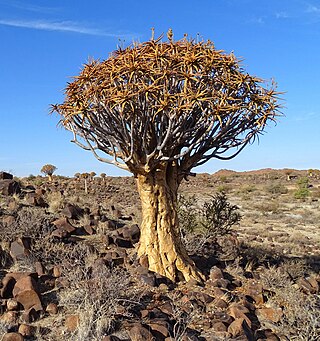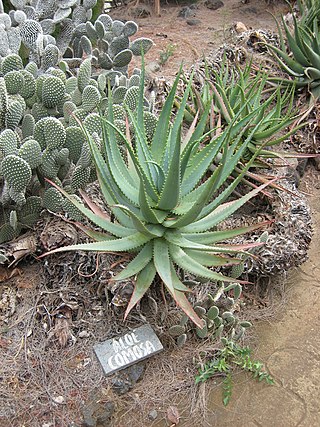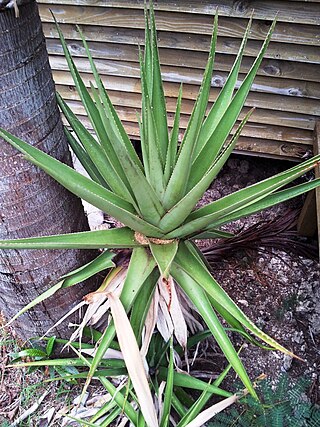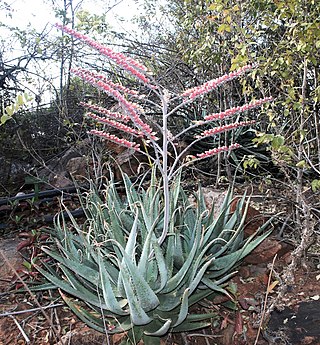
Aloe is a genus containing over 650 species of flowering succulent plants. The most widely known species is Aloe vera, or "true aloe". It is called this because it is cultivated as the standard source for assorted pharmaceutical purposes. Other species, such as Aloe ferox, are also cultivated or harvested from the wild for similar applications.

Aloidendron dichotomum, formerly Aloe dichotoma, the quiver tree or kokerboom, is a tall, branching species of succulent plant, indigenous to Southern Africa, specifically in the Northern Cape province of South Africa, and parts of Southern Namibia.

Phyla nodiflora, commonly known as the Turkey Tangle Fogfruit, is a species of flowering plant in the family Verbenaceae. It can be found in the Tropics around the globe. It is often grown as an ornamental plant for ground cover, and is often present in yards or disturbed areas.

Aloidendron barberae, formerly Aloe bainesii and Aloe barberae, also known as the tree aloe, is a species of succulent plant in the genus Aloidendron. It is native to South Africa northwards to Mozambique. In its native climes this slow-growing tree can reach up to 60 feet (18 m) high and 36 inches (0.91 m) in stem diameter. Aloidendron barberae is Africa's largest aloe-like plant. The tree aloe is often used as an ornamental plant. Its tubular flowers are rose pink (green-tipped); it flowers in winter and in its natural environment is pollinated by sunbirds.

Aloe ballyi is a species of flowering plant in the family Asphodelaceae, native to Kenya and Tanzania.

Aloe comosa is a species of flowering plant in the Asphodelaceae family. It is commonly called Clanwilliam aloe) and is endemic to South Africa.

Gonialoe dinteri, the Namibian partridge aloe, is a species of flowering plant in the Asphodelaceae family. It is native to arid areas of Angola and Namibia.

Aloidendron eminens, formerly Aloe eminens, is a species of succulent plant in the genus Aloidendron, endemic to Somalia.

Aloe squarrosa is a species of flowering plant in the Asphodelaceae family. It is from the island of Socotra, Yemen.
Aloe viridiflora is a species of plant in the genus Aloe. The species is endemic to Namibia with a wide range and is known from at least six different populations. Current trends are not known and the species is listed as LC on the IUCN Red List. However, it is scarce and Namibian authorities consider it threatened; the plant must not be removed or disturbed. It is the only known green-flowering aloe. Its natural habitats are dry savanna, subtropical or tropical dry shrubland, and rocky areas. It can produce hallucinations when ingested, leading to its occasional use in shamanic rituals.

Cynanchum socotranum, synonym Sarcostemma socotranum, is a species of plant in the family Apocynaceae. It is endemic to Socotra Island, south of Yemen. Its natural habitat is subtropical or tropical dry shrubland.

Kumara haemanthifolia is a species of flowering plant in the family Asphodelaceae. It is a rare species of succulent plant, native to a few high, inaccessible mountain peaks in the Fynbos habitat of Western Cape, South Africa.

Aloe jucunda is a species succulent plants that belong to the family Asphodelaceae, indigenous to Somalia.

Aloe sect. Lomatophyllum is a taxonomic section within the genus Aloe, comprising between 12 and 18 closely related species of Aloe from Madagascar and the Mascareigne islands.
Aloe pembana is a species of Aloe indigenous to the island of Pemba and surrounding islets, off the coast of Tanzania.

Aloe globuligemma, commonly known as the witchdoctor's aloe, is a species of flowering plant in the family Asphodelaceae. It is native to southern Africa where it occurs in semi-desert and dry bushland. It is an evergreen, succulent, perennial plant. The plant forms large, dense clumps. It is harvested from the wild for local medicinal use.

Aloidendron tongaense, formerly Aloe tongaensis, is a species of plant in the genus Aloidendron, native to sandy tropical coastal forests in KwaZulu-Natal, at the border between Mozambique and South Africa, and Mozambique.

John Jacob Lavranos was a Greek/South African insurance broker and botanist, with a special interest in succulents. The standard author abbreviation Lavranos is used to indicate this person as the author when citing a botanical name. He scientifically described almost 300 new species of plants, and a number have been named in his honor.

Aloestrela is a genus of flowering plants belonging to the family Asphodelaceae. This genus is named in honour of Professor Dr Estrela Figueiredo of the Department of Botany of the Nelson Mandela University. It contains the sole species Aloestrela suzannae(Decary) Molteno & Gideon F.Sm., endemic to Madagascar. Aloestrela suzannae is an endangered species indigenous to the south of Madagascar.
Aloe djiboutiensis is a species of aloe native to Djibouti and Eritrea. It was first described in 2007 in the CSSA Journal by T. A. McCoy.

















